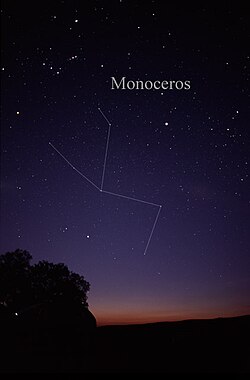Monoceros
Monoceros (Greek: Μονόκερως) is a constellation on the celestial equator.[1] Its name is Greek for unicorn. It was described by 17th-century Dutch cartographer Petrus Plancius. Orion is to the west of Monceros. Gemini is to the north. Canis Major is to the south. Hydra is to the east. Other constellations next to Monoceros are Canis Minor, Lepus and Puppis.
 Click for larger image | |
| List of stars in Monoceros | |
| Abbreviation: | Mon |
| Genitive: | Monocerotis |
| Symbology: | |
| Right ascension: | 7.15 h |
| Declination: | −5.74° |
| Area: | 482 sq. deg. (35th) |
| Main stars: | 4 |
| Bayer/Flamsteed stars: | 32 |
| Stars known to have planets: | 16 |
| Bright stars: | 0 |
| Nearby stars: | 2 |
| Brightest star: | β Mon (3.76m) |
| Nearest star: | Ross 614 ( ly) |
| Messier objects: | 1 |
| Meteor showers: | December Monocerids Alpha Monocerids |
| Bordering constellations: | Canis Major Canis Minor Gemini Hydra Lepus Orion Puppis |
| Visible at latitudes between +75° and −90° Best visible at 21:00 (9 p.m.) during the month of February | |
Notable features
Stars
Monoceros is hard to see with the naked eye. Its brightest star, Alpha Monocerotis, has a visual magnitude of 3.93. It is brighter than Gamma Monocerotis at 3.98.
Monoceros does have some interesting features to look at with a small telescope. Beta Monocerotis is a triple star system. The three stars form a triangle which looks to be in one spot. William Herschel commented that it is "one of the most beautiful sights in the heavens".[2]
Monoceros also has Plaskett's Star. It is a big binary system. Its whole mass is said to be that of almost 100 Suns put together. It is as hard to find as the cancer constellation.
Monoceros Media
The constellation Monoceros, from Urania's Mirror, a set of star charts from 1825. Includes Canis Minor and the obsolete constellation Printer's Workshop
References
- ↑ "Monoceros Constellation on Top Astronomer". www.topastronomer.com. Archived from the original on 2014-12-18. Retrieved 2014-09-16.
- ↑ http://90millimeter.org/2013/02/17/monocerotis/[dead link]
Further reading
- Levy, David H. (2005), Deep Sky Objects, Prometheus Books, ISBN 1-59102-361-0
- Ridpath, Ian; Wil Tirion (2007). Stars and Planets Guide. London/Princeton: Collins/Princeton University Press. ISBN 978-0-00-725120-9. (Princeton).
Other websites
| Wikimedia Commons has media related to Lua error in Module:Commons_link at line 62: attempt to index field 'wikibase' (a nil value).. |

